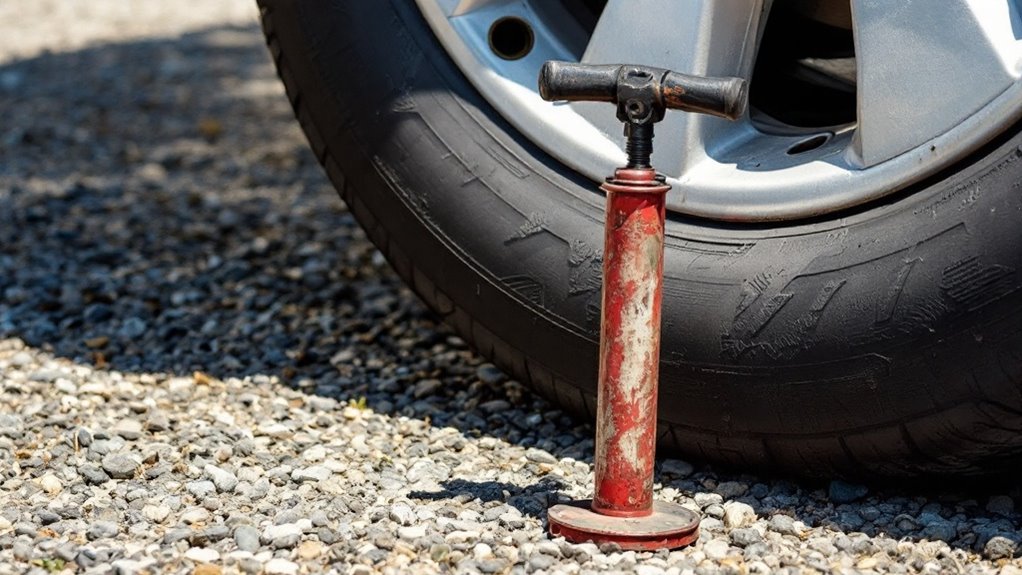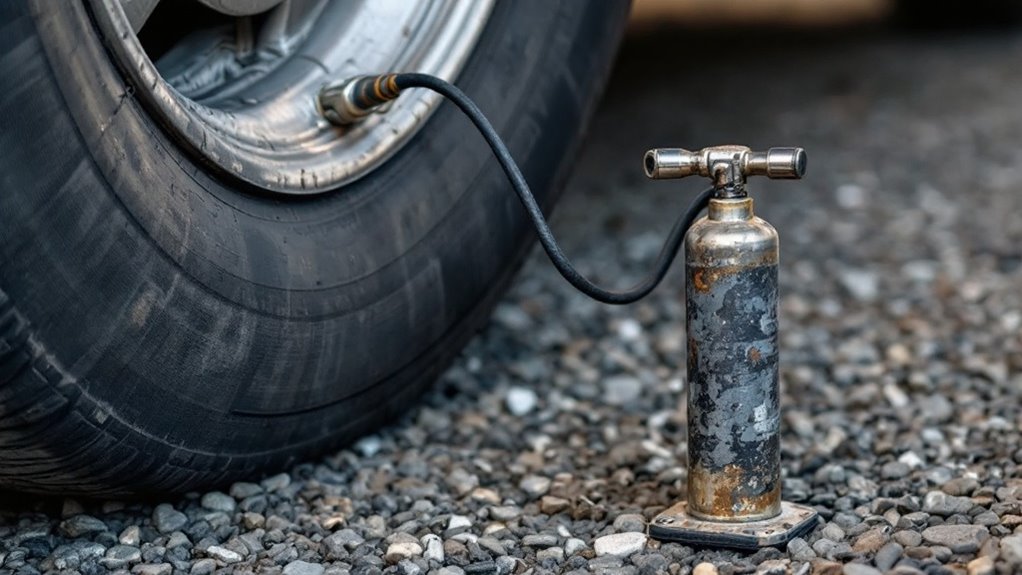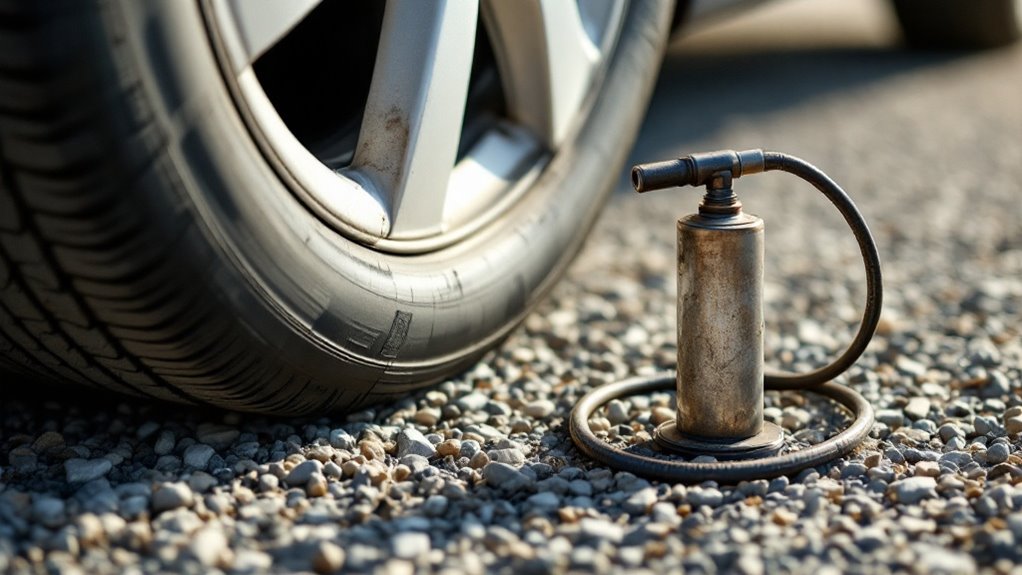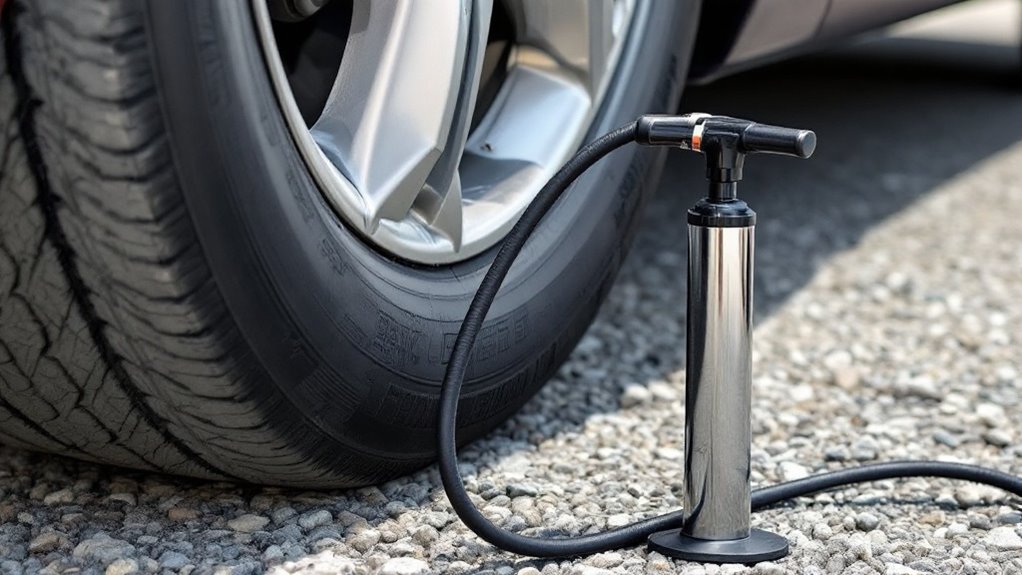Can You Fill A Car Tire With A Bicycle Pump
This post contains affiliate links. As an Amazon Associate, we earn from qualifying purchases.
Yes, you can use a bicycle pump for a car tire. But, it takes a lot of hard work. One tire might need 15 to 50 minutes to fill. A bicycle pump gives only 100-400cc of air per push. A car tire needs 30-40 liters of air total. Think about it—thousands of pumps for just a little pressure! Your arms will get super tired. Keep checking the tire pressure for safety. Wrong pressure can make driving dangerous. Want to know more? Let’s dive into the details of this tough task.
Essential Facts in 30 Seconds
- A bicycle pump can be used to fill a car tire in emergencies, though it’s not the best option.
- Inflation takes 15 to 50 minutes due to the pump’s low air output per stroke.
- The process requires significant physical effort and can cause fatigue.
- Continuous pressure monitoring is essential for safe inflation.
- Bicycle pumps are recommended only for temporary solutions, not regular use.
Understanding Valve Compatibility
Let’s talk about inflating car tires with a bicycle pump. First, know the valve types. Presta valves are thin and found on road bikes. They’ve a threaded tip. Schrader valves are wider and used on car tires. They don’t have a screw cap. Matching the right pump to the valve matters a lot. A wrong match can cause trouble or damage.
Here are some key tips to remember:
- Presta valves need special pumps or adapters for Schrader use.
- Schrader valves work with many modern dual-head bike pumps.
- Adapters help a Presta pump fit a Schrader valve easily.
Always check your pump before you start. Is it dual-head or adjustable? This quick step saves time and avoids problems. It ensures a tight and safe connection. You’ll inflate without any stress! Many bike pumps, especially floor pumps, are designed to accommodate both valve types for versatility.
Assessing Air Volume Challenges

Think about using a bicycle pump for a car tire. It’s tough! A bike pump pushes out very little air each time.
A car tire needs 30 to 40 liters of air. That’s huge compared to a bike tire. Bike tires are ten times smaller in volume.
So, you need thousands of pumps for just a bit of pressure. Imagine that! Pumping could take hours or even a full day. Progress feels so slow. Many users report that even after extensive effort, they only manage to add minimal PSI increases.
This method just doesn’t work for everyday needs. Stick to better tools for car tires!
Volume Per Stroke Limits
Pumping a car tire with a bicycle pump is tough. Many things make it hard. One big problem is volume per stroke. This means how much air comes out each pump. Bicycle pumps give only 100cc to 400cc per stroke. That’s very little for big tires. Each pump push takes lots of effort. Even the best pumps don’t help much. High-end bicycle pumps, however, can provide 25% more air per stroke compared to standard models.
Think about these limits:
- Low Air Output: Most pumps need thousands of strokes.
- Barrel Size Matters: Bigger barrels give more air, but not enough.
Car Tire Capacity Gap
Filling a car tire with a bicycle pump is super tough. Why? The size difference is huge! Car tires need way more air than bike tires. They often require 28 to 36 PSI for best results. A normal car tire holds about 1.85 cubic feet of air. That’s a lot, right?
Check this out for clarity:
- Car Tire Air: Around 1.85 cubic feet at start.
- Pressure Goal: Usually 32 to 35 PSI for cars.
A bicycle pump can’t keep up with this demand. The air volume is just too much.
Plus, the pressure needs are way higher. So, it’s not a practical choice. You’ll tire out before the tire fills!
Pumping Time Constraints
Pumping a car tire with a bicycle pump is tough. It takes a lot of effort and time. Sometimes, it can take minutes or even hours. Tire size matters a lot in this process. Bigger tires need more air, so you get tired fast. Smaller tires fill up quicker, but it’s still slow. The pump’s design isn’t great for car tires.
Check out these key challenges:
- Low Air Volume: Bike pumps push out very little air per stroke.
- High Pressure Issue: Car tires need more pressure, which takes forever.
You might feel exhausted before the tire is full. This method isn’t practical for daily use. It’s not good for emergencies either. Stick to better tools for tire care.
Evaluating Pressure Demands

Think about using a bicycle pump for a car tire. Sounds easy, right? But wait—there are big challenges to know! Car tires need 30-40 psi of pressure. Bicycle tires need much more, 50-150 psi. Still, car tires hold way more air. A bike pump works super slow for them.
Let’s break down key things to remember.
First, check car tire specs. Keep pressure at 32-35 psi for safety. Look at your car manual or door sticker.
Second, bike pumps fill tiny amounts. So, inflating a car tire takes forever.
Third, wrong pressure is risky. Too low or too high messes up driving. You could lose control!
Last, use a good gauge. Bike pump gauges may not be accurate, and regular vehicle maintenance is key to ensuring your tire pressure is consistently monitored.
Always test tire pressure when tires are cold. This gives the best reading!
Exploring Pumping Effort

Think about inflating a car tire using a bicycle pump. It’s a tough job! You need lots of strength and patience to keep going. This task really tests your body. Your arms and shoulders might get super tired. Sometimes, you pump for 20 minutes just for a little air.
Try different ways to make pumping easier. Switch arms to share the effort. Use your body weight to push the handle down. Here are some tips to help you:
- Keep a slow, steady pace to save energy.
- Rest a bit every few minutes to stay fresh.
- Stand on a firm spot for better balance.
Stick with it, and you’ll get the job done. It takes grit and smart moves to win!
Considering Time and Efficiency

Think about using a bicycle pump for a car tire. It’s a tough job! You spend a lot of time pumping. Tests show it takes 15-20 minutes if conditions are good. For a flat tire, expect up to 50 minutes. Compare that to just 4-6 minutes with a car inflator. That’s a huge difference, right?
Bike pumps work for bike tires, not car tires. Car tires need much more air.
Let’s break down the big challenges. First, bike pumps give little air per push. You need hundreds of pushes to fill a tire.
Second, your body gets tired fast. After 5-20 minutes, you feel exhausted.
Third, the pump can get too hot. This slows you down or damages it.
Last, valve adapters mightn’t fit well. This adds extra delays.
Prepare for a long task. You need patience and strength to do this!
Weighing Practical Applications

Let’s talk about using a bicycle pump for car tire inflation. Is it doable in real life? Yes, especially in emergencies like a flat tire on a lonely road. But, it’s not great for everyday use. Pumping takes a long time—often 15 to 50 minutes. Plus, it’s super hard work. You’ll feel tired fast.
Think about other options too. A bike pump can be a backup plan. Make sure it fits your car tire valve. Use a Schrader adapter if needed. Know the downsides, though. The pump might wear out. Pressure readings can be wrong if you stop midway.
Here’s a simple guide to help:
- Check the valve first. Does it match Schrader?
- Get ready to sweat. It’s tough physical work.
- Keep checking pressure. Use a gauge often.
- Remember that bike pumps typically have a pressure range suited for bike tires, which may not be optimal for car tires.
Stick to proper tools for safety and speed.
Analyzing Cost and Sustainability

Think about using a bicycle pump for inflating car tires. It’s cheap and good for the planet. A basic pump costs only $10 to $15. Compare that to public air stations charging $0.25 or more. Electric compressors also cost a lot more. A bicycle pump saves you money right away.
Now, look at the eco-friendly side. This tool uses no electricity or fuel. You cut down your carbon footprint easily. Every pump helps keep the air cleaner.
Check out these awesome benefits:
- Low Cost: Spend less money at the start.
- No Pollution: Keep the air clean with no emissions.
- Better Mileage: Proper tire pressure saves fuel and cash.
- Less Trash: A simple design means no electronic waste.
Using a bicycle pump also ensures you are maintaining proper tire pressure, which is crucial for vehicle performance and safety.
Go for a bicycle pump. Make a smart and green choice today. Enjoy savings and help the earth!
Reviewing User Insights

Ever tried inflating a car tire with a bicycle pump? It’s tough work!
Many users say it feels super draining. They sweat a lot during the process. Some share it takes 15 to 50 minutes per tire. That depends on the pump and tire size. Your energy matters too.
Think about all that time spent! People often stop for breaks. This task tests your strength big time. Real stories show it’s not easy at all. Additionally, proper tire pressure is essential for vehicle control and safety, making this method even more crucial to consider before diving in.
Let’s dive into these experiences. Understand if this method works for you.
User Effort Experiences
Ever tried inflating a car tire with a bicycle pump? It’s tough! Many people face real struggles with this task. The effort can wear you out fast.
Picture this—hundreds of pumps just to fill one tire. A flat tire makes it even harder to manage.
Here’s what you need to know about the effort:
- Hand pumps tire out your muscles quickly. You’ll need breaks often.
- Foot pumps help a bit with better push power. They save energy.
- Slow leaks force you to pump again and again. It’s exhausting!
- Topping off pressure feels easier than starting from zero. Small wins matter!
Time Investment Stories
Think about the time it takes to inflate a car tire. Using a bicycle pump can be a real challenge. For one tire, it might take 2 to 3 minutes. That’s for a small pressure boost.
But a near-flat tire? Expect 4 to 6 minutes of hard work. Some say it needs over 200 pumps per tire! Imagine doing all four tires. That could eat up 8 to 12 minutes.
Hand pumps make it even slower than floor pumps. Want to save time? Top off tires every few days for slow leaks. It’s repetitive, but doable.
Check this quick data:
- Small Boost: 2–3 minutes per tire
- Near-Flat: 4–6 minutes per tire
- All 4 Tires: 8–12 minutes total
Frequently Asked Questions
Can a Bike Pump Damage a Car Tire?
Be cautious with a bike pump on car tires. It might not work well. Wrong pressure can harm the tire. Overinflating could burst it. Too much stress might break the valve. Studies show mismatched tools cause 10% of tire issues. Stick to proper car pumps. Stay safe out there!
Are There Legal Issues Using Bike Pumps on Cars?
Watch your step on this topic! Bike pumps aren’t banned for car use. Still, problems can pop up fast. Wrong inflation might cause safety risks or crashes. Stay alert and check twice! Data shows improper tire pressure leads to 11,000 accidents yearly. Keep tires at the right level. Don’t guess—use a proper gauge. Safety always comes first, right? Stick to tools meant for cars.
How Does Weather Affect Bike Pump Performance?
Got a bike pump? Weather can mess with how it works. Cold days make pressure readings look wrong. Hot weather can do the same trick. Humidity? It might mess up the gauge too. Test your pump often to stay sure. Keep it accurate, no guesswork! Ever notice weird readings? Blame the weather sometimes. Stick to checking it daily. Easy fix, right?
Can Bike Pumps Inflate Other Vehicle Tires?
Yes, bike pumps can inflate tires on other vehicles! Think motorcycles or trailers. Always check the tire pressure first. Watch how fast you inflate them. Use the right adapters for a perfect fit. Keep pumping with steady effort. You can do this easily! Data shows most bike pumps work up to 120 PSI. That’s enough for many tires. Stay patient and keep at it!
What Safety Precautions Should Be Taken?
Stay safe while inflating tires with these easy tips. Always check tire pressure first. Overinflation can cause big problems. Use a pump that fits the valve well. A bad fit leads to leaks. Take short breaks to rest your hands. Tiredness can cause mistakes. Look at the tire for cuts or damage before starting. A damaged tire might burst. Keep yourself safe by following these steps.
Conclusion
Picture yourself trying to fill a car tire with a bicycle pump. It’s a tough task, right? You face big challenges like mismatched valves. The pressure is hard to reach too. Pumping takes forever—hours of hard work! Data shows car tires need 30-35 PSI. A bicycle pump struggles to hit even 10 PSI. Yes, you can do it in theory. But honestly, it’s not practical at all. Grab a proper air compressor instead. This tool works fast and easy. It fills tires in just minutes. Save your energy for other tasks. Trust me, a compressor beats the pump every time!
